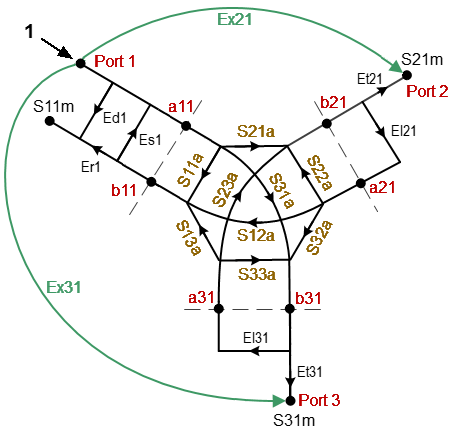A measurement result in a three-port system is affected by twenty-seven systematic error terms. The signal flow graph of error effects in the three-port system is represented in the figure below. The graph describes the case where Port 1 is the stimulus source.

S11a, S12a, S13a, S21a, S22a, S23a, S31a, S32a, S33a — actual value of DUT parameters
S11m, S12m, S21m, S21m, S22m, S23m, S31m, S32m, S33m — measured DUT parameters values
Three-port error model
note |
The systematic error terms are shown for Ports 1, Port 2 and Port 3. For other port triplets the systematic error terms will be similar. |
Systematic error terms in a three-port system are represented in the table below.
Description |
Stimulus Source |
||
|---|---|---|---|
Port 1 |
Port 2 |
Port 3 |
|
Directivity |
Ed1 |
Ed2 |
Ed3 |
Source match |
Es1 |
Es2 |
Es3 |
Reflection tracking |
Er1 |
Er2 |
Er3 |
Transmission tracking |
Et21, Et31 |
Et12, Et32 |
Et13, Et23 |
Load match |
El21, El31 |
El12, El32 |
El13, El23 |
Isolation |
Ex21, Ex31 |
Ex12, Ex32 |
Ex13, Ex23 |
After determination of all the twenty seven error terms for each measurement frequency by means of a three-port SOLT or TRL calibration, it is possible to calculate the true value of the S-parameters: S11a, S21a, … S33a.
note |
When using a three-port calibration, all nine measurements S11m, S21m, … S33m need to be known to determine any S-parameters. That is why updating one or all of the S-parameters necessitates three sweeps: with each port as a signal source. |
For a detailed description of calibration methods, see Calibration Methods and Procedures.